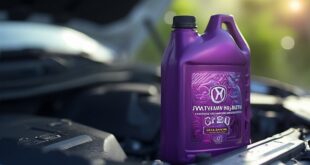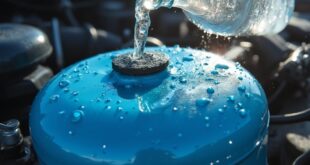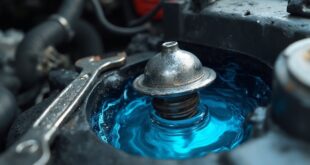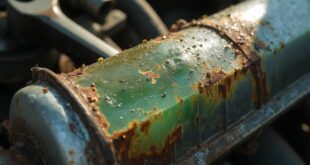You can expect around 0.25% coolant loss over six months, which translates to about 2-3 ounces annually. This slight decrease is normal, and regular monitoring of your coolant levels is crucial. However, if you notice persistent drops, it could signal a leak or other issues needing attention. Remember to check for visible signs of leaks and maintain proper coolant management practices to guarantee your engine stays healthy. There's more important information to keep in mind about coolant maintenance.
Understanding Normal Coolant Loss
Understanding normal coolant loss is essential for maintaining your vehicle's health.
It's normal for coolant levels to dip slightly over time, with up to 0.25% loss after six months, equating to about 2-3 ounces annually.
Regularly checking your coolant levels is vital; whenever you notice them low, top them off. If levels persistently drop, it's time for a system inspection.
Remember to change your coolant every 60,000 miles or four years, depending on your vehicle's maintenance schedule.
Staying on top of these checks helps prevent larger issues and keeps your engine running smoothly.
Common Causes of Coolant Loss
When your vehicle's coolant levels drop unexpectedly, it can be concerning, as several common issues may be at play.
Leaks from damaged hoses, radiator caps, or the heater core are frequent culprits. A blown head gasket can also mix oil and coolant, leading to serious problems.
Additionally, internal EGR cooler leaks might cause coolant to enter the exhaust, producing white smoke. Sometimes, leaks occur without visible signs, making regular checks essential.
Identifying these issues early can save you from more significant repairs down the road, so keep an eye on those coolant levels and inspect your system regularly.
The Risks Associated With Coolant Loss
Coolant loss poses significant risks to your vehicle's engine and overall performance, especially if not addressed promptly. A minor leak can escalate into severe problems, like sudden hose failure or engine overheating, leading to costly repairs.
If coolant levels drop too low, your engine may overheat, damaging critical components. Additionally, coolant leaks can harm the environment and pose hazards to children and pets.
Regular checks are essential, as internal leaks mightn't show visible signs. Ignoring coolant loss can result in major engine issues, so stay vigilant and fix any leaks immediately to protect your vehicle's longevity.
Evaporation vs. Actual Coolant Loss
How can you tell if your coolant levels are dropping due to evaporation or a genuine leak? It's crucial to understand that in a closed system, coolant shouldn't evaporate. Instead, it's usually water in the antifreeze that evaporates first. If you notice a persistent drop, it might indicate a leak.
| Indicator | Evaporation | Genuine Leak |
|---|---|---|
| Coolant Mixture | 50/50 coolant and water | Loss of coolant visible |
| Temperature Impact | Minor fluctuations | Overheating symptoms |
| Visual Signs | No visible signs | Puddles or stains |
| Frequency | Occasional checks | Regular monitoring |
Steps to Fix Coolant Loss
Addressing coolant loss promptly can save you from more significant engine issues down the road.
First, check for visible leaks around hoses, clamps, and the radiator. If you spot any damage, replace the affected parts immediately.
Next, test for a blown head gasket by examining oil for coolant contamination or checking for white smoke from the exhaust.
You might consider using a cooling system sealant for minor leaks, but don't rely on it long-term.
Regular maintenance is essential, so inspect your cooling system frequently and address any issues as they arise to guarantee your vehicle runs smoothly.
Proper Coolant Management Practices
Following repairs for coolant loss, maintaining proper coolant management practices confirms your vehicle operates efficiently and prevents future issues.
Always check your coolant levels regularly and top them off as needed. Remember, using water to dilute coolant isn't advisable; it reduces efficiency. If you find yourself adding water during emergencies, replace it with the correct coolant-to-water mixture as soon as possible.
Also, stick to recommended coolant changes every 60,000 miles or four years. Keeping your coolant system in check not only protects your engine but also confirms a smooth driving experience.
When to Seek Professional Help
While regular monitoring and maintenance can help prevent many coolant issues, there are times when it's crucial to seek professional help.
If you notice any of the following signs, don't hesitate to consult a mechanic:
- Persistent low coolant levels despite frequent top-offs.
- Overheating engine or a sudden temperature spike.
- Unusual coolant color or presence of oil in the coolant.
- Visible leaks under the vehicle or steam from the engine.
Ignoring these issues can lead to severe engine damage, so addressing them promptly guarantees your vehicle remains reliable and safe on the road.
Frequently Asked Questions
How Can I Tell if My Coolant Is Contaminated?
To tell if your coolant's contaminated, check for oil slicks or a milky appearance. Also, look for unusual odors or debris. If you notice any, consider flushing the system and replacing the coolant.
What Are the Signs of a Blown Head Gasket?
You'll notice signs of a blown head gasket through coolant leaks, white smoke from the exhaust, overheating, or milky oil. If you spot any, it's essential to get your vehicle inspected immediately.
Can Using the Wrong Coolant Cause Leaks?
Using the wrong coolant can indeed cause leaks. It may not properly seal joints or protect against corrosion, leading to failures in hoses or gaskets. Always check compatibility to avoid costly repairs down the road.
How Often Should I Check My Coolant Levels?
You should check your coolant levels regularly, ideally every month. Look for any drops in level, and top off as needed. Consistent monitoring helps prevent leaks and maintain your engine's cooling system efficiently.
Is It Safe to Mix Different Coolant Types?
Mixing different coolant types isn't safe; it can cause chemical reactions that reduce effectiveness and lead to engine damage. Stick to one type, and always check your owner's manual for the recommended coolant specifications.
 Car Service Land Coupons for Oil change, Tires, Wheel alignment, Brakes, Maintenance
Car Service Land Coupons for Oil change, Tires, Wheel alignment, Brakes, Maintenance




